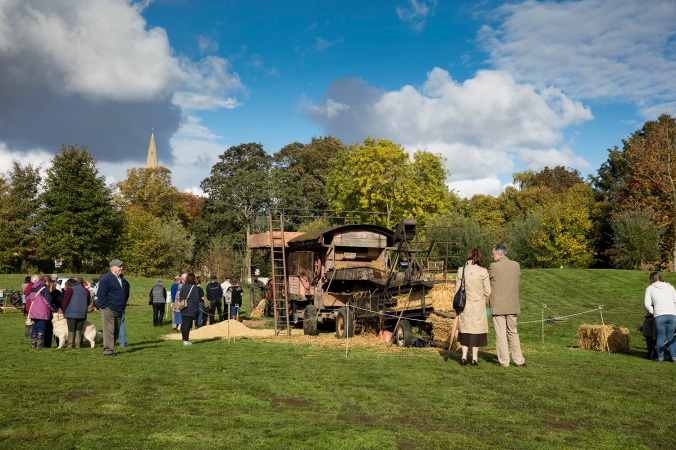This week was the week of the Winter Haecca, the main event of the second section of the Ridges & Furrows Project based in North Hykeham. The night before the event I loaded up a hired van with the ceramic lights, NKarts gazebo, pop up banners and Ridges & Furrows flags. I was very excited for the event as I had been involved from the very start; compared to the Welbourn Horkey when I was brought in a month into preparations. I was very interested also to see if the event would work as well in the dark. We had to come up with a different form of evaluation as we couldn’t give out surveys due to the light. We printed some postcards that had three questions on them, and to ensure we got a good amount of feedback, we gave away free glowsticks for every completed postcard that was handed back. The postcards were a beautifully designed set of four; each set were printed with either an earth, wind, fire or water design on the front (in the Ridges & Furrows style), and on the back was a corresponding fact about each theme’s connection with North Hykeham’s history.
On the morning of the event, myself and project historian Dave Reeves went to Lincoln to appear on BBC Radio Lincolnshire to publicise the Winter Haecca. Dave talked about the name Haecca, the town’s history and the event’s attractions. I had taken my accordion in and played Jo Freya’s processional tune. Interview starts at 02.11:40, my rendition of the processional tune can be heard at 02.18:45. Here is the link:
http://www.bbc.co.uk/programmes/p04hvz0z
On my return, the team had arrived with the loaded van; like the Horkey, many members of the NKarts partnership showed up to volunteer giving the event a nice feel of communal effort and we all shared in the magic of it. As the early dusk fell, we set about putting ceramic lanterns (that had been created for a previous project) around trees near a back entrance to the village green which created a fairy-circle effect and gave more colour to the dark, cold night.

A close up of the ceramic lanterns used to light up the Haecca
The town council’s part was coming together also, a big stage had been erected which was to accommodate the nativity play and the North Hykeham song performance. The Christmas stalls were also beginning to arrive and added noises and entrancing smells to the event. Half an hour before the scheduled start, the children from schools and the community workshops started to arrive and pick up their lanterns ready to process. Dave, Crauford and myself had a quick practice of the processional tune and awaited our marching order. The sun had gone down completely by the time we set off around the site, and the lanterns really stuck out against the night sky creating a beautiful effect. We led the star-lit cavalcade past the main stage, past our aerial performance area, through the stalls and over the little beck at the back of the green. We placed the lanterns into the ground at the far side of the beck so people on the main site could see the lanterns still shining across the water.
After the procession, our aerial volunteers started their performance. Our dance team had been running workshops in Boston for months and the volunteers really rose to the occasion. The blue and white lighting, twinned with ambient music and smoke bombs created a beautiful atmosphere in which the dancers looked graceful and professional on the silks. It drew a huge crowd which gave great feedback. The performance was a beautiful addition to the evening and something that was a welcome surprise to the entranced onlookers.
After the Town Council’s nativity play and children’s Christmas songs, Crauford and I took to the stage to direct the North Hykeham Song written by artist Jo Freya. The school children and the High Notes choir performed very well and the stage, packed with people, created a beautiful noise that carried far into the town.

Members of the High Notes Choir perform the North Hykeham Song
The amazing aerial dancers gave the crowd another performance and people gradually dispersed over the next half an hour. It was a beautiful event, the bright lanterns, artworks, dance displays and the community’s singing filled the winter night with warmth and delight. The Haecca had a very different feel to the Horkey, it was all taking place on the green, compared to the many venues in Welbourn. The effort that both artsNK and the Town Council went to to make the event light and festive surpassed the Horkey as the green was lovely to look at. While being less historically informative than the Horkey, due to the light not be accommodating to setting up information boards, we hoped that due to the facts on the feedback postcards and the history woven into the art the Ridges & Furrows artists and the community created, the people of North Hykeham learnt a little more about their local heritage.











































